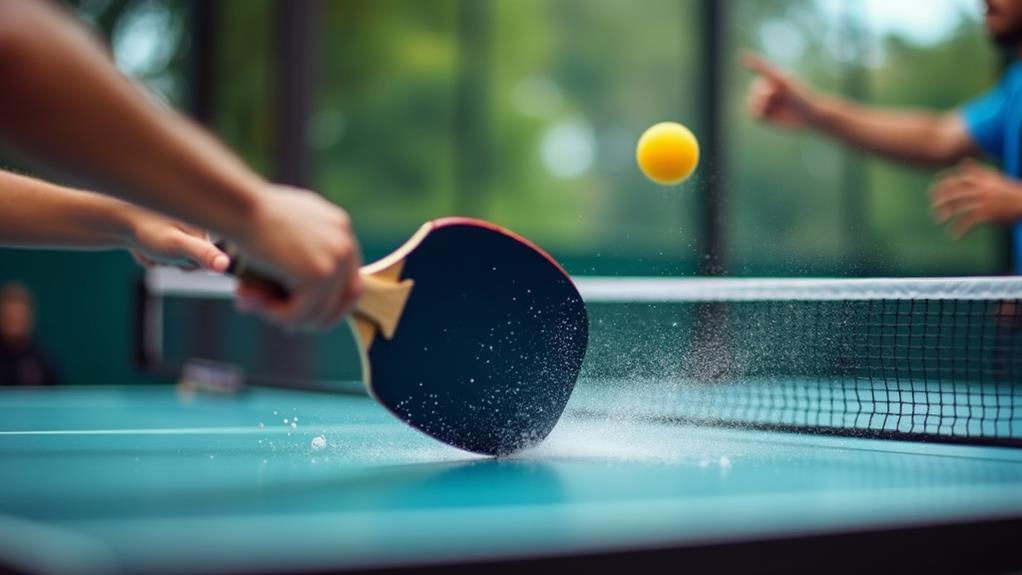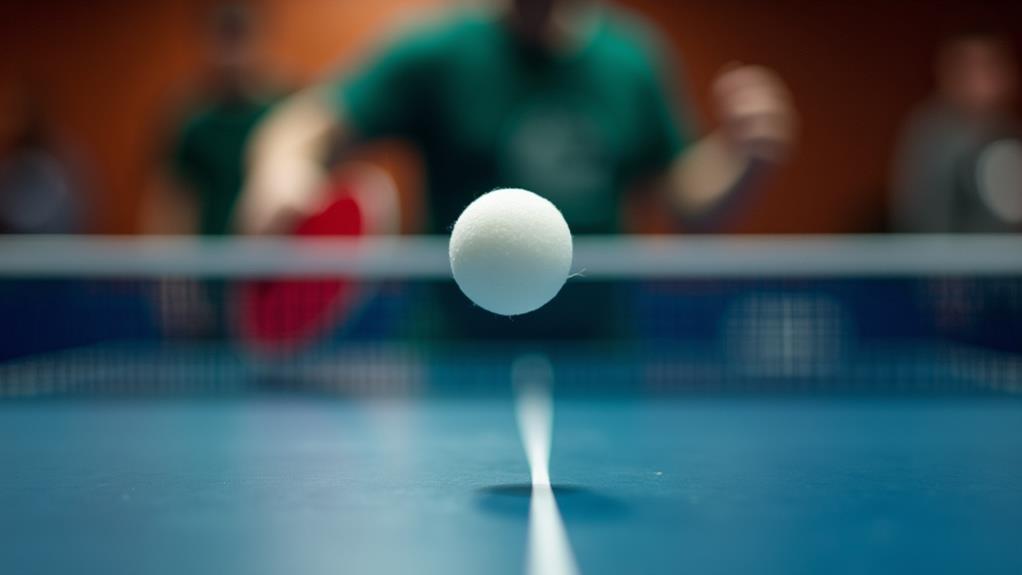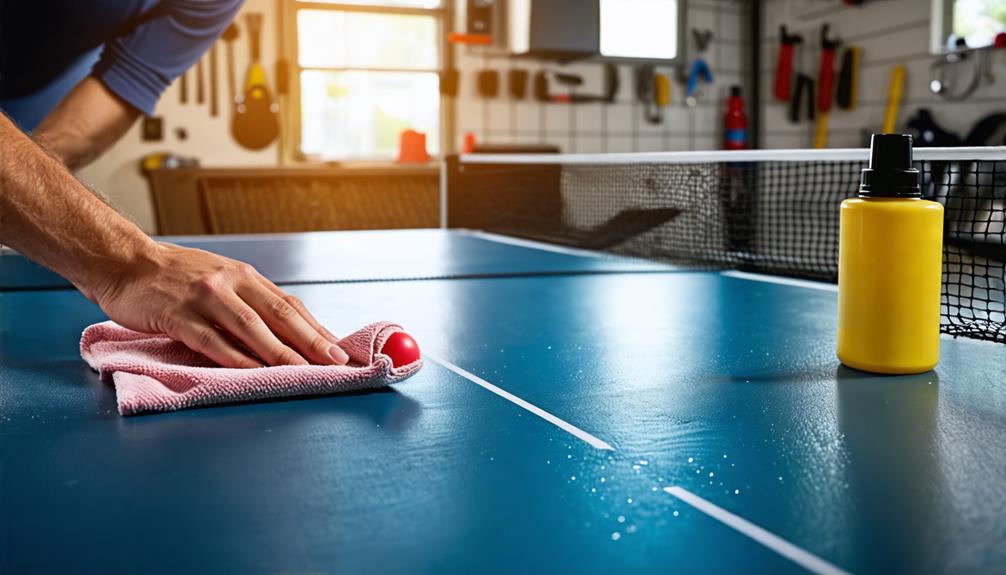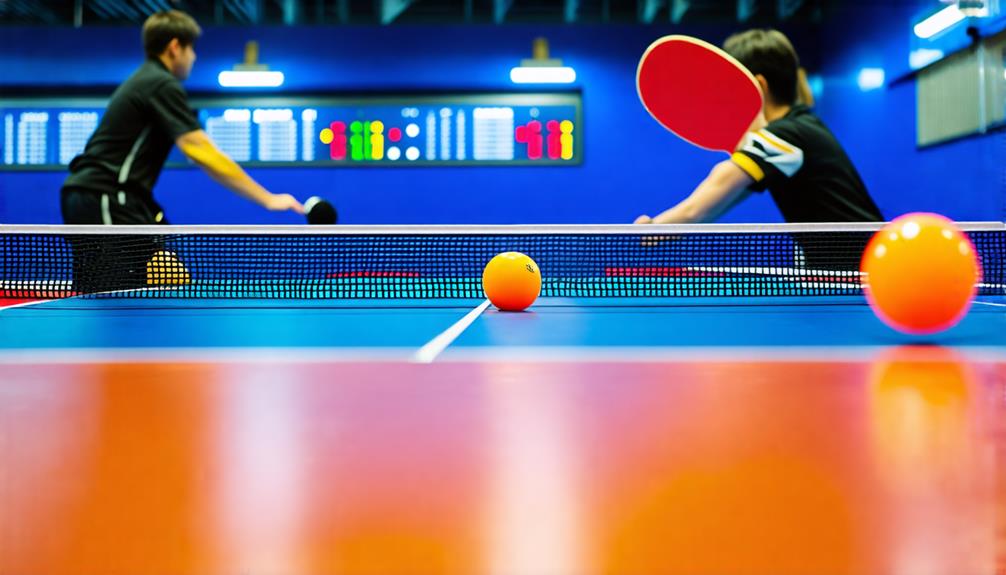What Are the Five Rules of Table Tennis?

To play table tennis, initially, matches usually go up to 11 points and you must win by 2. Serves alternate every two points, but at 10-10 they switch each point. Verify your serve tosses the ball at least 6 inches and it hits both sides of the table correctly. If the ball touches the net on a serve yet lands correctly, it's a let and you re-serve without penalty. Never volley – hitting the ball before it bounces loses you the point. Finally, respect the honor system for any disputes. There's even more to learn about the intricacies of the game.
Game Structure
Understanding the game structure of table tennis is crucial for both new and seasoned players. In table tennis, each game is played to 11 points, and you must win by at least a 2-point margin. Matches are often structured as the best of any odd number of games, commonly either 3 or 5 games. This means that the initial player to win more than half of the games in the match wins the entire match.
Before the match starts, a coin toss determines the starting server and which side each player will begin on. The player who wins the coin toss can choose to serve or receive initially, or select which side of the table to start on. Once the match begins, players alternate serving every two points. If the score reaches 10-10, also known as deuce, players then alternate serves on each point until one player achieves the 2-point lead necessary to win the game.
The initial server in one game will become the first receiver in the next game, ensuring fairness in the game structure. Understanding these rules helps you navigate the competitive and strategic aspects of table tennis effectively.
Serving Rules
Serving rules in table tennis are essential for guaranteeing fair play and maintaining the flow of the game. When you serve the ball, you must toss it straight up at least 6 inches before striking it on the way down. This guarantees visibility for the umpire and fairness in the serve. The serve must hit your side of the playing surface initially, clear the net, and then land on your opponent's side.
In singles play, the served ball can land anywhere on the opponent's side. However, in doubles, it must land in the opponent's diagonal service court. If the served ball hits the net but still lands in the correct area on the opponent's side, it is called a let serve and must be re-served without penalty.
Players alternate serving every two points, but when the score reaches 10-10, you alternate serves on each point. This keeps the game dynamic and fair, especially during intense moments.
- Toss the ball at least 6 inches high.
- Serve must hit your side initially.
- Serve must clear the net and land on the opponent's side.
- Let serve occurs if the ball touches the net but lands correctly.
- Alternate serving every two points; at 10-10, alternate each point.
Ball Landing

After mastering the serving rules, it's time to focus on where the ball lands during play. When you serve or receive initially in singles play, the ball must bounce at least once on the opponent's side for it to be valid and in play. If the ball doesn't hit your opponent's table, you lose the point. Furthermore, edge balls that touch the top surface of the table, even if just barely, are considered valid and in play.
In doubles, the rules are a bit stricter. The serve must land in the correct diagonal half of your opponent's side. This means you need to be precise with your serve, as hitting the wrong side will result in a point for your opponents. During rallies, players on each side must alternate hitting the ball, making teamwork essential.
Rally Conduct
Even if you've mastered your serve, the real game begins during the rally. This is where your skills truly shine as you and your opponent exchange strikes, each trying to outplay the other. In doubles, make certain you and your partner alternate hitting the ball. This keeps the game fair and guarantees everyone contributes to the rally.
Remember these key points during a rally:
- No volleying: Hitting the ball before it bounces on your side results in a point loss.
- Back over the net: If the ball bounces back over the net without being touched by your opponent, you score a point.
- Edge balls: Balls that hit the top surface of the table are valid and should be played.
- Honor system: Resolve any disagreements through the honor system if there's no referee.
- Stay in bounds: Keep the ball within the table boundaries to continue the rally.
Miscellaneous Rules

Regarding table tennis, understanding the miscellaneous rules is crucial for maintaining a fair and competitive environment. Adhering to the table tennis rules guarantees everyone plays the point correctly. If the ball hits the net during a serve and lands correctly, the serve alternates between players. However, if a player obstructs the ball before it bounces on their side, the opponent earns a point.
Touching the table with your free hand results in a point for the opponent. This rule emphasizes the importance of proper conduct and positioning. Likewise, any movement of the table due to player contact awards a point to the opponent, maintaining the integrity of the game.
In cases without a referee, players must respect the honor system to resolve disagreements, promoting fair play and sportsmanship. These rules apply uniformly across all levels, guaranteeing consistent enforcement.
For those seeking more detailed guidance, the full official rules of table tennis are accessible at USATT.org. Understanding these miscellaneous rules will help you master the game of the match, guarantee you serve every point correctly, and enjoy the competitive spirit across the number of games you play.



